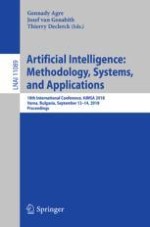2018 | Buch
Artificial Intelligence: Methodology, Systems, and Applications
18th International Conference, AIMSA 2018, Varna, Bulgaria, September 12–14, 2018, Proceedings
herausgegeben von: Gennady Agre, Prof. Dr. Josef van Genabith, Thierry Declerck
Verlag: Springer International Publishing
Buchreihe : Lecture Notes in Computer Science
